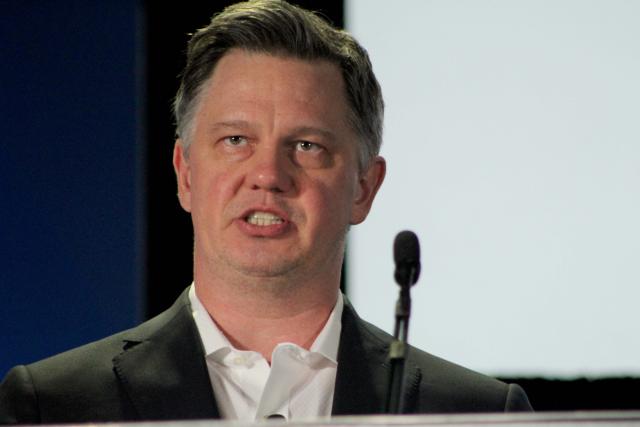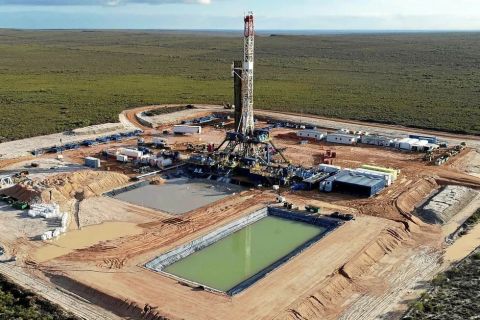
Rob Bruant, director of product at B3 Insight, spoke to DUG Midcontinent Conference and Exhibition attendees on the state of wastewater in the Anadarko Basin. (Source: Mary Holcomb, Hart Energy)
OKLAHOMA—Sand and water are largely considered as indispensable ingredients to hydraulic fracturing. Though, as oil and gas operators have continued to optimize completion designs, providers of services related to these key resources have had to adjust.
Experts in sourcing proppant and completion water as well as in produced-water recycling and disposal recently described current best practices and challenges in the Midcontinent region during Hart Energy’s DUG Midcontinent Conference and Exhibition.
“On a year-by-year basis there is about a billion barrels of water difference between the amount of water that’s going down a disposal well and the amount that could be potentially used or reused for hydraulic fracturing,” Rob Bruant, director of product at B3 Insight, told DUG Midcon attendees in November.
The handling of produced water from oil and gas development has presented an ongoing issue for the U.S. fracking industry.
In July, Bloomberg reported that the Permian Basin—an area spanning across West Texas and southeastern New Mexico—would need roughly $9 billion over the next decade to mitigate produced water from the shale play. The Permian’s water growth will call for nearly 1,000 additional saltwater disposal (SWD) wells by 2030, according to Raymond James analyst Marshall Adkins.
As a multibasin issue, experts in the Anadarko Basin are also seeing challenges with current water utilization practices, i.e. recycle, reuse and SWD wells.
Water Utilization Snapshot
At B3 Insight, an oilfield water intelligence data and analytics company, Bruant said the firm is working to integrate Oklahoma’s water resources information from oil fields with its data platform to better understand what water utilization looks like “past, present and future.”
“We’re trying to get an understanding of what that differential is so that we can better address some of the optionality that we might have in addition to utilization of saltwater disposal wells,” he said.
Aware that production plays a significant role in water utilization, Bruant’s data forecasts a decline in the next few years in the number of wells that are spud and subsequently completed. Although, a rebound is expected in 2024 and 2025. Thus, he projects degradation in water utilization as the number of wells drilled and rig activity declines.
“Even if we expect to see modest growth in oil and gas production and even a slight downturn in rig activity and number of wells drilled, we still think that there’s going to be a pretty sizeable differential between water volume that is being subsequently disposed in a saltwater disposal well and the water that could potentially be reused for well completions,” he said.
Bruant said one thing that is problematic for the state of Oklahoma and the interpretation of the data is that there isn’t a really good understanding of produced water volumes on a per well basis. But, even if 100% of produced water was recycled and/or reused, that wouldn’t accommodate all the produced water. According to Bruant, SWD wells would still be needed and “other opportunities for beneficial use of [the] water either inside the oil and gas industry or outside the oil and gas industry.”
An easier and low-cost alternative, he said, is evaporation techniques or ponds to manage the water. However, with produced water having variable compositions throughout Oklahoma, the solids load remaining after this process presents further obstacles.
Bruant explained that the best mitigation alternative toward saltwater disposal is the concentration of the produced water.
“Splitting the stream into a fresh or pure water stream and a concentrated brine, that concentrated brine then gets sent to a disposal well,” he said. “Therefore, you’re basically using less subsurface volume for disposal and ultimately you have—potentially—another product that can be used with the new oil and gas industry or outside of it.”
With overall costs working as a key driver for water management, Bruant said that operators are achieving cost parity between SWD and clean brine utilization, which “is a good thing.”
In regards to capacity challenges in the Anadarko Basin, Bruant considers water disposal as a very localized issue.
“There are definitely spots of high volumetric utilization on a per well basis, but there’s also a well-distributed number of wells that are operating at very low operational capacity with regard to disposed volume,” he said. “If you aggregate over the entire Anadarko Basin, only about 12% of the permitted volume is actually being utilized. But, again—location, location, location. It matters where you are, where your water production is and where your SWD wells are that really dictates whether or not you have a capacity issue or not.”
On the upside, Bruant said the emergence of water midstream businesses have provided a network for stranded disposal capacity and reduced the costs associated with water movement by installing fixed infrastructure vs. trucking.
Sourcing Sand
Despite seeing a decline in completion activity across basins, Westwood Energy Group’s head of NAM & Unconventionals Todd Bush projects frac sand demand in the Midcontinent region will see a slight increase.
“As some frac sand companies begin to adjust to that new frac sand demand and changes from the operators and clients, we started to see more companies on the supply side begin shutting in mines or just temporarily holding back production,” he said. “So, you started to see this huge run-up in frac sand in the Permian and then move into South Texas, in the Haynesville and the Midcon.”
In particular, as mines serving the Midcon come online, the region will average 5,500 tons per well to total 11 million pounds by 2022. Companies that are specifically in Oklahoma’s Merge, he said, will see a 15 million pound average by the same year.
With the demand in the Midcontinent bringing new mines online in 2020, opportunities will open for E&Ps to directly source sand, according to Bush.
“In the past, many operators have shied away from direct sourcing sand and chemicals and really working more through the pressure pumper,” he said. “Now, I think a number of operators show cost savings really driving down the well completion and the total cost of the program.”
Bush said companies are saving between $150,000 to $200,000 per well, and in some scenarios that can reach up to $600,000 to $700,000 a well depending on where the company is located and its proximity to the mine.
“As we move forward we’re expecting more and more companies to think about how they integrate with third-party logistic companies, sand and chemicals, and really begin thinking about this integrated value chain,” he added.
Recommended Reading
Brett: Oil M&A Outlook is Strong, Even With Bifurcation in Valuations
2024-04-18 - Valuations across major basins are experiencing a very divergent bifurcation as value rushes back toward high-quality undeveloped properties.
Marketed: BKV Chelsea 214 Well Package in Marcellus Shale
2024-04-18 - BKV Chelsea has retained EnergyNet for the sale of a 214 non-operated well package in Bradford, Lycoming, Sullivan, Susquehanna, Tioga and Wyoming counties, Pennsylvania.
Triangle Energy, JV Set to Drill in North Perth Basin
2024-04-18 - The Booth-1 prospect is planned to be the first well in the joint venture’s —Triangle Energy, Strike Energy and New Zealand Oil and Gas — upcoming drilling campaign.
PGS, TGS Merger Clears Norwegian Authorities, UK Still Reviewing
2024-04-17 - Energy data companies PGS and TGS said their merger has received approval by Norwegian authorities and remains under review by the U.K. Competition Market Authority.
Energy Systems Group, PacificWest Solutions to Merge
2024-04-17 - Energy Systems Group and PacificWest Solutions are expanding their infrastructure and energy services offerings with the merger of the two companies.




